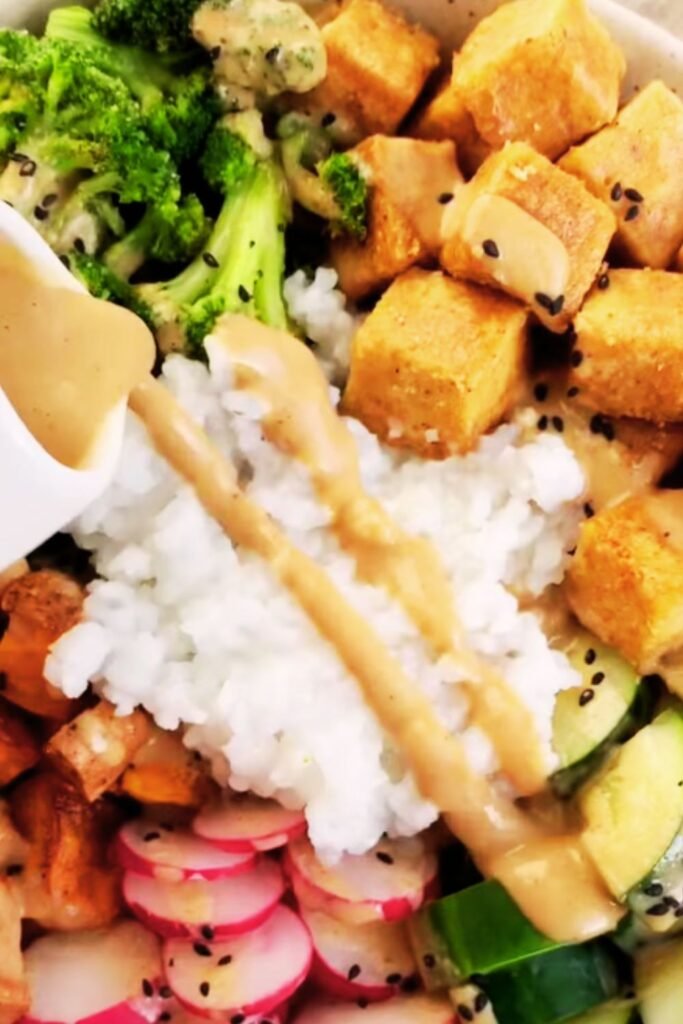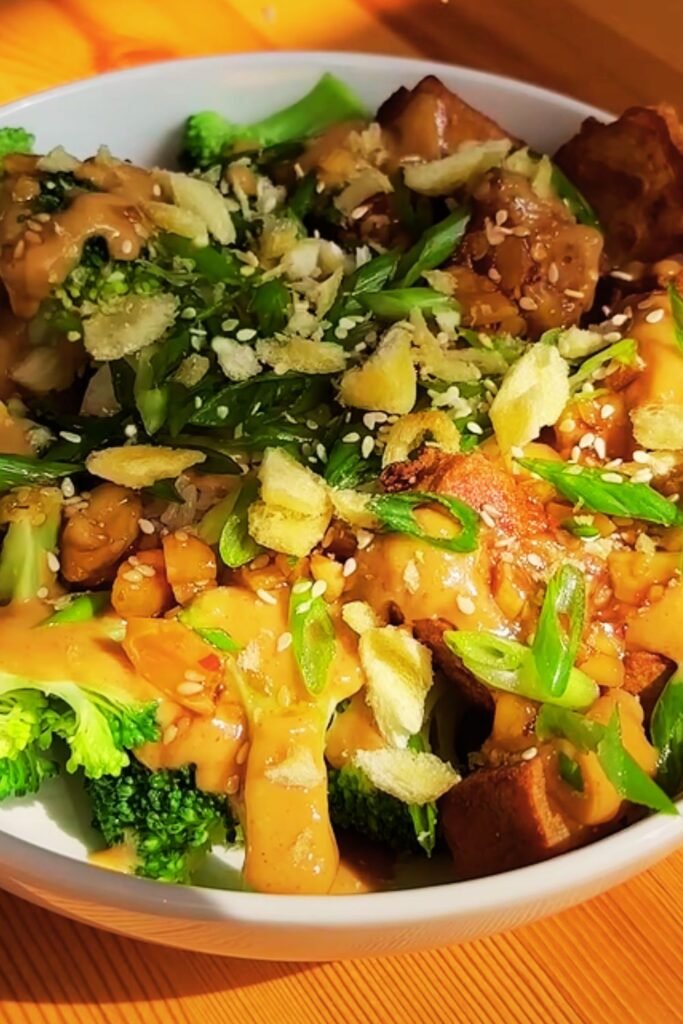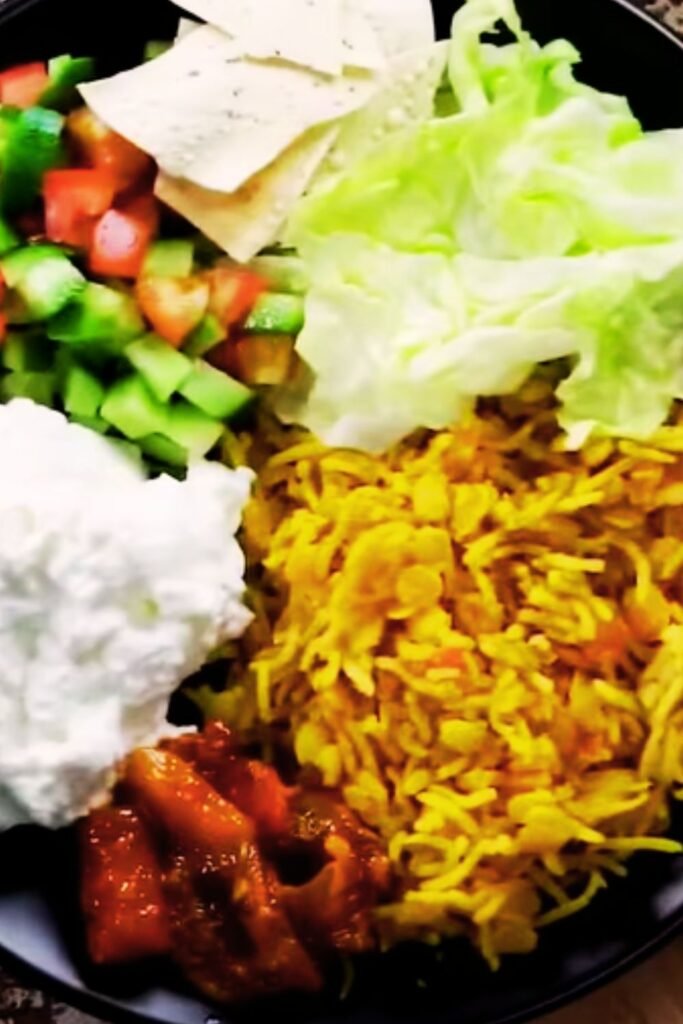When I first discovered Thai Peanut Chicken Buddha Bowls, I knew I’d found something special. This dish combines everything I love about healthy eating with the bold, vibrant flavors of Thai cuisine. The result? A meal that’s as nourishing as it is delicious, packed with protein, fresh vegetables, and that irresistible peanut sauce that makes everything better.
Buddha bowls have become my go-to solution for busy weeknights when I want something wholesome but don’t have hours to spend in the kitchen. What makes this Thai-inspired version particularly exciting is how it transforms simple ingredients into something that feels like a restaurant-quality meal. The combination of tender chicken, crisp vegetables, and that creamy peanut sauce creates a harmony of textures and flavors that keeps me coming back for more.
What Makes Thai Peanut Chicken Buddha Bowls Special
The beauty of this dish lies in its perfect balance. Unlike heavy takeout meals that leave you feeling sluggish, these bowls energize rather than drain. The protein from the chicken keeps you satisfied, while the array of fresh vegetables provides essential vitamins and minerals. The peanut sauce, despite its rich flavor, is surprisingly light when made with natural ingredients.
I’ve been making variations of this recipe for years, and what I love most is its adaptability. Whether you’re meal prepping for the week or hosting a casual dinner party, these bowls can be customized to suit any dietary preference or ingredient availability. The base recipe serves as a foundation, but the possibilities for personalization are endless.
Essential Ingredients for Success
Creating the perfect Thai Peanut Chicken Buddha Bowl starts with understanding your ingredients. Each component plays a crucial role in the final dish, and knowing how to select and prepare them makes all the difference.
The Protein Foundation
For the chicken, I always opt for boneless, skinless thighs over breasts. While chicken breasts are certainly an option, thighs remain more tender and flavorful, even if slightly overcooked. The extra fat content helps the meat stay moist during cooking, which is essential when you’re grilling or pan-searing.
When selecting chicken, look for pieces that are similar in size to ensure even cooking. I typically buy about 1.5 pounds for four generous servings, which allows for some leftovers – trust me, you’ll want them.
Vegetable Medley
The vegetable selection is where creativity really shines. My standard lineup includes:
Crunchy Elements:
- Fresh bell peppers (red, yellow, or orange for sweetness)
- Carrots (julienned or shredded for easy eating)
- Red cabbage (thinly sliced for color and crunch)
- Cucumber (diced for freshness)
Leafy Greens:
- Baby spinach or mixed greens as the base
- Fresh cilantro for aromatic brightness
- Thai basil when available (regular basil works too)
Cooked Vegetables:
- Broccoli florets (lightly steamed)
- Sugar snap peas (quickly blanched)
- Edamame (shelled and cooked)

The Star: Peanut Sauce
The peanut sauce is what elevates this from a simple chicken and vegetable bowl to something extraordinary. My version balances creamy richness with tangy brightness and just enough heat to keep things interesting.
Key Peanut Sauce Ingredients:
- Natural peanut butter (creamy or crunchy)
- Fresh lime juice
- Rice vinegar
- Soy sauce (low sodium preferred)
- Fresh ginger
- Garlic
- Sriracha or chili garlic sauce
- Sesame oil
- Honey or maple syrup
Detailed Recipe and Preparation
Thai Peanut Chicken Buddha Bowl Recipe
Serves 4
For the Chicken:
- 1.5 lbs boneless, skinless chicken thighs
- 2 tablespoons olive oil
- 1 teaspoon garlic powder
- 1 teaspoon ground ginger
- 1 teaspoon paprika
- 1/2 teaspoon salt
- 1/4 teaspoon black pepper
- 1 tablespoon soy sauce
For the Peanut Sauce:
- 1/2 cup natural peanut butter
- 3 tablespoons fresh lime juice
- 2 tablespoons rice vinegar
- 2 tablespoons soy sauce
- 1 tablespoon honey
- 1 teaspoon sesame oil
- 1 teaspoon fresh ginger, minced
- 2 cloves garlic, minced
- 1-2 teaspoons sriracha (adjust to taste)
- 2-4 tablespoons warm water (for consistency)
For the Bowl Assembly:
- 4 cups cooked brown rice or quinoa
- 4 cups mixed greens
- 1 red bell pepper, sliced
- 1 large carrot, julienned
- 1 cup red cabbage, thinly sliced
- 1 cucumber, diced
- 1 cup edamame, shelled
- 1/2 cup fresh cilantro
- 1/4 cup chopped peanuts
- Lime wedges for serving
Step-by-Step Preparation
Preparing the Chicken
Start by marinating the chicken thighs. In a bowl, combine olive oil, garlic powder, ground ginger, paprika, salt, pepper, and soy sauce. Add the chicken and let it marinate for at least 30 minutes, though overnight marination yields even better results.
When ready to cook, heat a large skillet or grill pan over medium-high heat. Cook the chicken for 6-7 minutes per side, or until the internal temperature reaches 165°F. The key is not to move the chicken too early – let it develop a nice golden crust before flipping.
Once cooked, let the chicken rest for 5 minutes before slicing. This resting period allows the juices to redistribute, ensuring every bite is tender and flavorful.
Crafting the Perfect Peanut Sauce
The peanut sauce is surprisingly simple but requires the right technique. I start by whisking together the peanut butter, lime juice, and rice vinegar in a bowl. This creates the acidic base that will brighten the rich peanut flavor.
Next, I add the soy sauce, honey, sesame oil, minced ginger, garlic, and sriracha. The key is to whisk constantly while gradually adding warm water until you reach the desired consistency. The sauce should be pourable but not too thin – think of it as slightly thicker than heavy cream.
Taste and adjust seasonings. Need more heat? Add sriracha. Want more brightness? Include extra lime juice. The sauce should balance sweet, salty, spicy, and tangy elements.

Bowl Assembly Strategy
Assembly is where the magic happens. I like to think of it as creating an edible work of art. Start with a base of warm rice or quinoa in each bowl. This provides a neutral foundation that absorbs the flavors of the sauce.
Next, arrange the mixed greens on one side of the bowl. The contrast between the warm rice and cool greens creates temperature variation that makes each bite interesting.
Now comes the fun part – arranging the vegetables. I like to group similar colors together for visual impact. Place the sliced bell peppers in one section, the julienned carrots in another, and the shredded cabbage in a third. This creates distinct flavor zones while maintaining visual appeal.
Add the diced cucumber and edamame for pops of color and texture. Finally, place the sliced chicken prominently in the center or along one edge of the bowl.
Nutritional Information Table
| Nutrient | Per Serving | % Daily Value |
|---|---|---|
| Calories | 485 | 24% |
| Protein | 35g | 70% |
| Carbohydrates | 45g | 15% |
| Dietary Fiber | 8g | 32% |
| Total Fat | 22g | 34% |
| Saturated Fat | 4g | 20% |
| Sodium | 650mg | 27% |
| Potassium | 890mg | 25% |
| Vitamin C | 85mg | 94% |
| Iron | 3.2mg | 18% |
Customization Options and Variations
One of the reasons I fell in love with Buddha bowls is their incredible adaptability. Once you master the basic technique, you can customize them to suit any taste preference or dietary requirement.
Protein Variations
While chicken is my go-to protein, I’ve experimented with numerous alternatives. Tofu works beautifully when pressed, cubed, and pan-fried until golden. The key is to press out excess moisture and allow the tofu to develop a crispy exterior.
For seafood lovers, shrimp makes an excellent substitute. Season with the same spice blend and cook for just 2-3 minutes per side. Salmon, either grilled or baked, adds omega-3 fatty acids and pairs wonderfully with the peanut sauce.
Vegetarians can opt for tempeh, which has a nutty flavor that complements the peanut sauce beautifully. Marinate it in the same mixture used for chicken, then pan-fry until heated through.
Grain Alternatives
Brown rice is my standard base, but I’ve discovered that different grains can completely transform the dish. Quinoa adds a subtle nutty flavor and provides complete protein. Wild rice offers a chewier texture and earthy taste that pairs well with the Thai flavors.
For those avoiding grains entirely, cauliflower rice makes an excellent low-carb substitute. Sauté it briefly with a little oil and salt until tender but still slightly crisp.
Seasonal Vegetable Swaps
The beauty of Buddha bowls lies in their seasonal adaptability. In spring, I incorporate fresh asparagus and pea shoots. Summer calls for cherry tomatoes and fresh corn. Fall brings roasted butternut squash and Brussels sprouts, while winter features roasted root vegetables and hearty kale.

Meal Prep and Storage Guidelines
These bowls are meal prep champions. I often prepare components on Sunday for quick weekday assembly. The key is storing each component separately to maintain optimal freshness and texture.
Component Storage Table
| Component | Storage Method | Shelf Life | Best Practices |
|---|---|---|---|
| Cooked Chicken | Refrigerated in airtight container | 3-4 days | Slice just before serving |
| Peanut Sauce | Refrigerated in sealed jar | 5-7 days | Whisk before using |
| Cooked Grains | Refrigerated in containers | 4-5 days | Reheat with splash of water |
| Raw Vegetables | Refrigerated in separate containers | 3-5 days | Keep in crisper drawer |
| Leafy Greens | Refrigerated with paper towel | 3-4 days | Wash just before use |
Assembly Timeline
For the freshest results, I recommend assembling bowls just before eating. However, if you need to prep complete bowls, layer the ingredients strategically. Place the grains at the bottom, followed by heartier vegetables, then proteins, and finally delicate greens on top. Store the peanut sauce separately and add just before eating.
Troubleshooting Common Issues
Over the years, I’ve encountered and solved numerous Buddha bowl challenges. Here are the most common issues and their solutions:
Soggy Vegetables
This usually happens when vegetables are cut too far in advance or stored improperly. Cut vegetables on the day of serving when possible, and always pat them dry before adding to the bowl.
Dry Chicken
Overcooking is the usual culprit. Use a meat thermometer to ensure accuracy, and remember that chicken will continue cooking slightly after removing from heat.
Sauce Consistency Problems
If your peanut sauce becomes too thick, thin it with warm water one tablespoon at a time. If it’s too thin, add more peanut butter or let it sit – it will thicken as it cools.
Bland Flavors
This often means under-seasoning individual components. Season the chicken marinade well, add salt to cooked grains, and don’t be afraid to taste and adjust the peanut sauce.
Health Benefits and Nutritional Advantages
What makes these bowls particularly satisfying is their nutritional completeness. Each component contributes essential nutrients, creating a meal that nourishes on multiple levels.
The lean protein from chicken provides all essential amino acids needed for muscle maintenance and growth. The variety of vegetables ensures a wide range of vitamins, minerals, and antioxidants. The peanut sauce, despite its indulgent taste, contributes healthy fats and additional protein.
The fiber content from vegetables and whole grains promotes digestive health and helps maintain stable blood sugar levels. This combination of protein, healthy fats, and complex carbohydrates creates sustained energy rather than the spike-and-crash cycle common with processed foods.
Serving Suggestions and Presentation
Presentation matters more than you might think. I’ve found that taking an extra minute to arrange components thoughtfully makes the meal feel more special and satisfying.
Use large, shallow bowls to showcase all the colorful ingredients. Create height by mounding the rice slightly in the center, then arranging other components around it. Drizzle the peanut sauce artfully over the top, and finish with a sprinkle of chopped peanuts and fresh herbs.
For entertaining, consider setting up a Buddha bowl bar. Prepare all components separately and let guests build their own bowls. This approach accommodates different preferences and dietary restrictions while creating an interactive dining experience.
Frequently Asked Questions
Q: Can I make this recipe ahead of time? I recommend preparing components separately and assembling just before serving. The chicken and sauce can be made up to 3 days ahead, while vegetables are best prepared the day of serving.
Q: Is this recipe suitable for meal prep? Absolutely! These bowls are perfect for meal prep. Store components separately and assemble throughout the week. The flavors actually improve as they meld together.
Q: Can I substitute the peanut butter in the sauce? Yes, almond butter or sunflower seed butter work well as substitutes. The flavor will be slightly different, but still delicious.
Q: How spicy is the peanut sauce? The heat level is easily adjustable. Start with less sriracha and add more to taste. The sauce should have a gentle warmth rather than overwhelming heat.
Q: Can I make this vegetarian? Certainly! Replace the chicken with pressed and cubed tofu, tempeh, or additional vegetables. The peanut sauce pairs beautifully with plant-based proteins.
Q: What if I don’t have all the listed vegetables? Buddha bowls are incredibly flexible. Use whatever vegetables you have on hand. The key is balancing colors, textures, and flavors.
Q: How long does the peanut sauce last? Properly stored in the refrigerator, the sauce keeps for 5-7 days. Always give it a good stir before using, as separation is normal.
Q: Can I freeze the cooked chicken? Yes, cooked chicken can be frozen for up to 3 months. Thaw completely in the refrigerator before using, and note that the texture may be slightly different.
Q: Is brown rice necessary, or can I use white rice? Either works perfectly. Brown rice provides more fiber and nutrients, while white rice offers a milder flavor and softer texture.
Q: How do I prevent the avocado from browning if I want to add it? Add avocado just before serving, or toss sliced avocado with a little lime juice to slow browning. Store separately if meal prepping.
This Thai Peanut Chicken Buddha Bowl has become a cornerstone of my healthy eating routine. It proves that nutritious food doesn’t have to be boring or complicated. With its vibrant colors, bold flavors, and satisfying combination of textures, it’s a meal that makes eating well feel like a celebration rather than a chore.
The beauty of this recipe lies not just in its delicious taste, but in its ability to adapt to your preferences and lifestyle. Whether you’re a busy professional looking for quick meal prep options or a home cook wanting to impress family and friends, these bowls deliver on all fronts. They’re proof that the best meals are often the simplest ones – when quality ingredients are combined thoughtfully, the results speak for themselves.